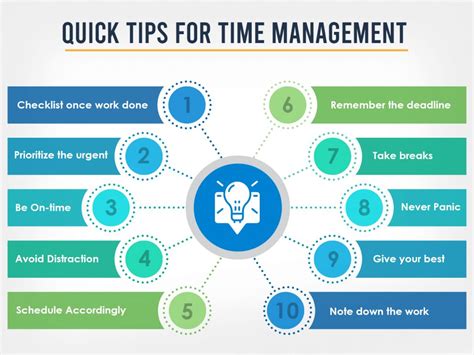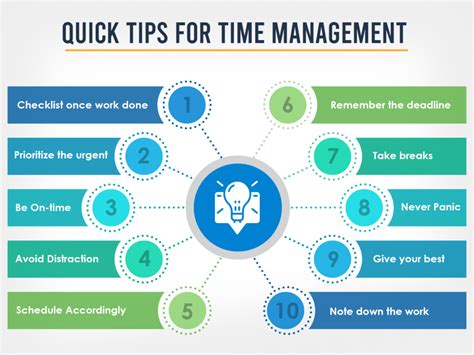Are you constantly struggling to find enough hours in the day and feeling overwhelmed by your never-ending to-do list? We live in a fast-paced society where time is a precious resource, and mastering the art of efficient time utilization is crucial for achieving success in both personal and professional spheres. But fear not – there are proven strategies that can help you regain control of your time and increase your productivity.
Optimize Task Prioritization
One of the key factors in effective time management is the ability to prioritize tasks. By identifying the most important and urgent tasks, you can allocate your time and energy more efficiently. Make use of the Eisenhower Matrix, a simple yet powerful tool that categorizes tasks into four quadrants: important and urgent, important but not urgent, urgent but not important, and neither urgent nor important. This method helps you focus on essential activities while eliminating or delegating less important ones.
Master the Art of Task Delegation
Delegating tasks is often seen as a sign of weakness or inefficiency, but in reality, it is a strategic move that enables you to free up valuable time for more important responsibilities. Identify tasks that can be assigned to others, whether it's through outsourcing, collaboration, or seeking assistance from team members. Not only does delegation lighten your workload, but it also provides an opportunity for skill development and fosters a sense of teamwork and shared responsibility.
Eliminate Time-Wasting Activities
We all have those time-draining activities that offer little value but still manage to consume a significant chunk of our day. Whether it's mindlessly scrolling through social media, indulging in unproductive conversations, or succumbing to distractions, these habits can severely hamper your time management efforts. Take a proactive approach to identify and eliminate such time-wasters from your daily routine. Restrict your access to non-essential websites, set specific time limits for recreational activities, and establish boundaries to protect your focus and concentration.
Cultivate Effective Planning and Organization Techniques
No matter how proficient you are at prioritizing tasks, delegation, and eliminating time-wasting activities, without proper planning and organization, your efforts may go in vain. Adopt techniques such as creating a to-do list, breaking down complex tasks into smaller, manageable sub-tasks, setting realistic deadlines, and using productivity tools or apps to stay organized. A well-structured approach to planning allows you to visualize your goals, track progress, and adapt to unforeseen circumstances, ensuring a seamless and efficient workflow.
Mastering Time: Strategies for Efficiently Managing Your Schedule

In the fast-paced world we live in, mastering time is essential for success. Effective time management strategies can help you maximize productivity, accomplish your goals, and find a healthy work-life balance. This section will explore various techniques and approaches that can be employed to efficiently manage your time.
Optimizing productivity starts with prioritizing tasks and organizing your schedule. By identifying the most important and time-sensitive tasks, you can allocate your time and resources accordingly. Additionally, breaking down larger tasks into smaller, more manageable chunks can make them less overwhelming and easier to tackle.
Another strategy to consider is setting clear goals and deadlines. By setting specific and achievable goals, you can stay focused and motivated. Setting deadlines for yourself can also create a sense of urgency and prevent procrastination.
Effective time management also involves managing distractions and staying focused. Minimizing interruptions, such as turning off notifications on your phone or computer, and creating a dedicated workspace can help increase your concentration and productivity. Additionally, employing techniques like the Pomodoro Technique, where you work in focused bursts with short breaks in between, can help maintain productivity levels.
Delegating tasks and learning to say no are also important aspects of efficient time management. Recognizing when to delegate tasks to others can free up your time to focus on higher priority responsibilities. Learning to say no to non-essential commitments can help you protect your valuable time and prevent overstretching yourself.
Lastly, taking care of your physical and mental well-being is crucial for effective time management. Prioritizing self-care through activities like exercise, meditation, and getting enough sleep can improve your energy levels, focus, and overall productivity.
By implementing these strategies, you can take control of your time and become a master of efficiency. Remember, managing your time effectively is not about doing more, but about doing the right things in the most efficient way possible.
Prioritizing Your Tasks: Maximizing Your Efficiency
When it comes to managing your time effectively, one crucial aspect to focus on is the ability to prioritize your tasks. This means organizing and arranging your tasks in order of importance, so that you can allocate your time and energy efficiently. By prioritizing your tasks, you can ensure that you are focusing on the most significant and impactful activities, enabling you to make the most of your available time.
Identify Your Key Objectives:
Before diving into your tasks, take a step back and reflect on your overall goals. What are the main objectives you aim to achieve? By clearly understanding your priorities and long-term objectives, you can align your tasks with these goals. This will help you determine which tasks are most significant and warrant immediate attention.
Classify Tasks: Urgent vs Important:
Not all tasks are created equal, and it is crucial to differentiate between urgency and importance. Urgent tasks typically have deadlines and demand immediate attention, while important tasks may not be time-sensitive but contribute significantly to your long-term goals. By categorizing your tasks according to their urgency and importance, you can prioritize effectively and avoid wasting time on less critical activities.
Consider Difficulty and Effort:
Some tasks may take relatively more effort and time to accomplish, while others can be completed quickly. Evaluating the difficulty and effort required for each task can help you determine the order in which they should be prioritized. If a task requires substantial effort, it may be wise to tackle it earlier in the day when you are most focused and energized.
Use Visual Aids:
To better visualize and organize your tasks, you can create to-do lists, task boards, or use digital tools such as project management software. By having a clear visual representation of your tasks, you can easily identify which ones need immediate attention and track your progress efficiently. This visual aid can serve as a constant reminder of your priorities and keep you on track.
Reevaluate and Adapt:
Remember that prioritizing tasks is not a one-time process, but an ongoing practice. As circumstances change and new tasks arise, it is essential to reassess and readjust your priorities accordingly. Regularly reviewing your task list and adapting as needed can help you stay focused and ensure that you are consistently allocating your time and energy to the most crucial activities.
Final Thoughts:
Prioritizing your tasks is a fundamental skill that can significantly improve your time management abilities. By identifying key objectives, classifying tasks based on urgency and importance, considering difficulty and effort, utilizing visual aids, and regularly reevaluating your priorities, you can enhance your efficiency and make the most of your time. Remember, efficient time management starts with effective task prioritization.
Setting Clear and Attainable Goals

In order to make the most of your time and achieve optimal productivity, it is crucial to establish clear and feasible objectives. By outlining and prioritizing your goals, you give yourself a sense of purpose and direction.
When setting goals, it is important to be specific and articulate about what you want to achieve. Ambiguity can lead to confusion and wasted time. By clearly defining your goals, you can focus your efforts and make better use of your time.
Additionally, setting attainable goals is key to effective time management. While it is important to push yourself and strive for excellence, be realistic about what you can accomplish in a given timeframe. Setting overly ambitious goals can demotivate and overwhelm you, ultimately hindering your progress.
It is also beneficial to break down larger goals into smaller, more manageable tasks. This allows you to track your progress and make steady strides towards the ultimate goal. By setting milestones and deadlines for each task, you create a roadmap that guides your time management efforts.
Finally, regularly reassess and adjust your goals as needed. As circumstances change, priorities may shift, and it is important to adapt accordingly. By regularly evaluating your goals, you ensure that they remain relevant and achievable, helping you stay focused and on track.
Create an Effective Daily Schedule
Organizing your day can greatly improve your productivity and help you make the most of your time. By creating a well-planned daily schedule, you can efficiently manage your tasks and ensure you accomplish your goals.
Start by prioritizing your tasks based on their importance and urgency. Identify the key activities that need to be completed and allocate specific time slots for each task. Consider using time-blocking techniques to allocate dedicated periods for individual tasks or groups of similar tasks.
Establishing a routine can also be helpful in managing your time effectively. Determine the most productive periods of your day and schedule your most important tasks during those times. This way, you can take advantage of your peak energy levels and focus on completing tasks that require higher concentration.
Be realistic when creating your schedule and factor in breaks and downtime. It is essential to recharge and take short breaks to maintain your energy levels and prevent burnout. Assigning time for relaxation and activities you enjoy can also contribute to a healthier work-life balance.
Regularly review and adjust your daily schedule as needed. Evaluate your progress and make necessary changes to optimize your time management. Adaptability is key to ensuring your schedule remains efficient and suits your evolving needs.
Lastly, consider utilizing technology and productivity tools to streamline your scheduling process. There are various time management apps and digital calendars available that can assist in organizing your tasks, setting reminders, and providing insights into how you're allocating your time.
By creating a well-structured daily schedule, you can take control of your time, enhance your productivity, and achieve your goals more efficiently.
Learn the Power of Saying "No"

In order to optimize the utilization of your time and enhance productivity, it is crucial to acquire the skill of asserting yourself by saying "no" when necessary. While it may be challenging at times to decline certain requests or commitments, learning to decline in a respectful and assertive manner can be a game changer when it comes to efficient time management.
Saying "no" allows you to prioritize your tasks and focus on activities that align with your goals and priorities. It helps you avoid overcommitting yourself and spreading your time and energy too thin. By setting clear boundaries and making conscious choices about how and when you allocate your time, you can avoid unnecessary stress and achieve a better work-life balance.
When faced with requests or opportunities that do not align with your priorities or do not contribute significantly to your personal or professional growth, it is important to recognize that saying "no" is not a sign of weakness. In fact, it demonstrates self-awareness, self-respect, and the ability to make informed decisions. By politely declining these distractions or obligations, you create room for activities that truly matter to you and allow yourself to fully engage in tasks that are essential for your success.
Learning to say "no" effectively requires clear communication and a firm understanding of your own priorities and limits. It is essential to remember that it is okay to say "no" without providing elaborate explanations or justifications. However, it is important to do so with empathy and respect for the other person's perspective. By utilizing phrases such as "I appreciate your offer, but I am currently focusing on other obligations" or "I would love to help, but I already have prior commitments," you can assert your boundaries while maintaining positive relationships.
By mastering the art of saying "no," you gain control over your time and create opportunities for meaningful engagements. Remember, your time is a precious resource, and by learning to say "no" when necessary, you are empowering yourself to make intentional choices that contribute to your overall efficiency and success.
Breaking Down Large Tasks into Smaller Ones: A Key to Effective Time Management
When it comes to managing our time efficiently, one important strategy to consider is breaking down big tasks into smaller, more manageable ones. By doing so, we can prevent overwhelming ourselves and increase our productivity by focusing on achievable steps.
1. Divide and conquer: Instead of being daunted by a large task, it is beneficial to divide it into smaller chunks. This allows us to approach it systematically, tackling one part at a time. By breaking it down, we can focus our efforts on specific aspects and gradually make progress towards completion.
2. Set clear objectives: Defining clear objectives for each smaller task helps us stay focused and motivated. By setting realistic goals, we can measure our progress, maintain momentum, and monitor how much time we allocate to each subtask.
3. Prioritize subtasks: Once we have broken down a larger task, it is essential to prioritize the subtasks. Identifying the most critical aspects ensures that we allocate our time and resources wisely. By working on the most crucial aspects first, we create a solid foundation for further development.
4. Maintain a to-do list: In order to keep track of the smaller tasks, it is helpful to maintain a to-do list. By having a visual representation of the tasks that need to be completed, we can stay organized and avoid overlooking any important steps. A list also allows us to prioritize and rearrange tasks as needed.
5. Celebrate milestones: Breaking down big tasks into smaller ones provides us with numerous milestones to celebrate along the way. By acknowledging our progress and achievements, we stay motivated and maintain a positive mindset. Recognizing and rewarding ourselves for completing each smaller task encourages us to continue working efficiently.
- Divide and conquer
- Set clear objectives
- Prioritize subtasks
- Maintain a to-do list
- Celebrate milestones
Avoiding Procrastination

In this section, we will explore effective strategies for avoiding procrastination and maximizing your productivity. Procrastination refers to the act of intentionally delaying or postponing tasks, often due to a lack of motivation or a sense of overwhelm. By implementing the following techniques, you can overcome procrastination and make the most of your time.
- Set clear and achievable goals: Begin by defining specific goals for each task or project. Break them down into smaller, manageable steps, making it easier to stay focused and motivated.
- Create a prioritized to-do list: List all your tasks in order of importance and urgency. Start with the most critical ones and work your way down. This approach ensures that you tackle important tasks first and minimizes the likelihood of procrastination.
- Eliminate distractions: Identify potential distractions in your environment, such as social media notifications, phone calls, or irrelevant emails. Minimize or remove these distractions to maintain your concentration and workflow.
- Utilize time-blocking techniques: Allocate specific blocks of time for different tasks or activities. This method helps you stay organized, enhances focus, and prevents procrastination by dedicating fixed periods solely to the task at hand.
- Practice the "two-minute rule": If a task takes less than two minutes to complete, do it immediately. By promptly addressing quick tasks, you prevent them from accumulating and becoming overwhelming.
- Adopt the Pomodoro Technique: This time management technique involves working on a task for a focused period, such as 25 minutes, followed by a short break. Breaks help prevent burnout and keep your energy levels high.
- Develop a positive mindset: Combat procrastination by cultivating a positive mindset. Believe in your abilities to accomplish tasks, focus on the benefits of completing them, and reward yourself for achieving milestones.
- Seek accountability and support: Share your goals and progress with a trusted friend or colleague who can hold you accountable. Having someone to support and motivate you can be invaluable in fighting procrastination.
By applying these strategies to your daily routine, you can overcome procrastination and efficiently manage your time, leading to increased productivity and achieving your goals.
Delegate Responsibilities
In order to optimize your use of time and improve productivity, it is essential to effectively delegate responsibilities. Delegation involves assigning tasks and responsibilities to others, allowing you to focus on more important or strategic aspects of your work. By delegating effectively, you can distribute the workload, utilize the skills of others, and ensure that tasks are completed efficiently and in a timely manner.
Here are several key strategies to consider when delegating responsibilities:
- Identify suitable tasks to delegate: Assess your workload and identify tasks that can be effectively handled by others. Consider the expertise, skills, and availability of potential individuals to ensure that tasks are assigned to the most appropriate person.
- Clearly communicate expectations: When delegating, clearly communicate the objectives, expectations, and deadlines for the assigned tasks. This will help avoid misunderstandings or delays, ensuring that everyone understands their roles and responsibilities.
- Provide necessary resources: To enable successful completion of delegated tasks, provide the individuals with the necessary resources, such as access to information, tools, or training. This will empower them to effectively carry out their assigned responsibilities.
- Establish accountability: Establish a system for regular check-ins or progress updates to ensure accountability and monitor the progress of delegated tasks. This will help identify any challenges or roadblocks early on and allow for timely adjustments.
- Foster trust and empowerment: Trust your team members and empower them to make decisions and take ownership of their assigned tasks. Encourage open communication, provide support, and recognize their efforts to build a positive and productive working environment.
- Evaluate and provide feedback: Once tasks are completed, evaluate the outcomes and provide feedback to the individuals involved. Recognize their achievements, identify areas for improvement, and provide guidance for future assignments.
By effectively delegating responsibilities, you can free up your time to focus on higher-level tasks, enhance the capabilities of your team, and achieve greater overall efficiency in your work.
Utilize Time Organization Tools and Approaches

In order to effectively manage and utilize your time, it is crucial to employ various time organization tools and techniques. These resources assist in optimizing productivity, prioritizing tasks, and minimizing time wastage.
One effective technique is the use of productivity applications and software. These innovative tools provide features such as task lists, reminders, and calendars, enabling individuals to organize and schedule their activities efficiently. Additionally, these applications often offer synchronization across multiple devices, allowing for seamless access and updates.
Another valuable resource is the implementation of time tracking methods. By tracking and analyzing the time spent on different tasks, individuals can gain insight into their productivity patterns and identify areas for improvement. This can be achieved through the use of time tracking apps, online timers, or even manual time logs.
Additionally, incorporating effective planning strategies can significantly enhance time management. Techniques such as the Eisenhower Matrix, Pomodoro Technique, or Agile Methodology provide frameworks for prioritizing tasks, managing interruptions, and fostering focus and productivity.
Furthermore, utilizing project management tools can aid in efficient time allocation and task delegation. These tools enable individuals and teams to plan, schedule, and track progress on various projects simultaneously, ensuring that deadlines are met and resources are utilized effectively.
In conclusion, by utilizing various time organization tools and techniques, individuals can optimize their time management skills and achieve greater productivity. Whether through the use of productivity applications, time tracking methods, planning strategies, or project management tools, these resources assist in managing tasks, prioritizing activities, and minimizing time wastage, ultimately leading to improved efficiency and effectiveness.
Take Breaks and Practice Self-Care
Managing your time efficiently goes beyond just scheduling and prioritizing tasks. It is also crucial to incorporate regular breaks and practice self-care. Taking breaks and practicing self-care allows you to recharge your energy, enhance focus, and maintain productivity throughout the day.
One way to incorporate breaks into your day is by implementing the Pomodoro Technique. This technique involves working on a task for a focused period, typically 25 minutes, and then taking a short break. After completing a few pomodoros, you can take a longer break to relax and rejuvenate. These breaks allow your brain to rest and prevent burnout, ultimately improving overall productivity.
In addition to taking regular breaks, practicing self-care is essential for effective time management. Engaging in activities that promote well-being, such as exercise, meditation, or hobbies, can help reduce stress levels and increase mental clarity. By prioritizing self-care, you are investing in your long-term productivity and finding a balance between work and personal life.
Creating a self-care routine can include setting aside specific time each day for activities that promote relaxation and self-nurturing. This could involve reading a book, going for a walk in nature, or simply taking a few moments to practice deep breathing exercises. By consistently incorporating self-care into your schedule, you can enhance your overall well-being and make the most out of your time.
| Benefits of Taking Breaks and Practicing Self-Care: |
| - Enhanced focus and concentration |
| - Reduced stress levels |
| - Improved overall productivity |
| - Enhanced well-being and work-life balance |
| - Prevention of burnout |
In conclusion, incorporating regular breaks and practicing self-care are essential components of efficient time management. By giving yourself permission to take breaks and prioritize self-care activities, you can improve your focus, reduce stress, and ultimately enhance productivity and well-being in both your personal and professional life.
FAQ
How can I improve my time management skills?
To improve your time management skills, you can try prioritizing your tasks, setting deadlines, creating to-do lists, and eliminating distractions. It's also important to plan your day in advance and allocate specific time slots for each activity.
What are some common time management mistakes?
Some common time management mistakes include procrastination, taking on too many tasks, not delegating responsibilities, not setting clear goals, and not taking breaks. It's important to be aware of these mistakes and make conscious efforts to avoid them.
How does effective time management improve productivity?
Effective time management improves productivity by helping you focus on the most important tasks, minimizing wasted time, and ensuring deadlines are met. It also reduces stress and allows for better work-life balance, leading to increased overall productivity.
What are some useful tools or techniques for time management?
There are various tools and techniques for time management. Some popular ones include using productivity apps or software, practicing the Pomodoro Technique (working in focused bursts with short breaks in between), employing the Eisenhower Matrix (prioritizing tasks based on urgency and importance), and using time tracking tools to monitor how time is spent.
How can I overcome procrastination and distractions?
To overcome procrastination and distractions, you can try breaking large tasks into smaller, more manageable ones, setting specific deadlines, creating a conducive work environment free from distractions, using productivity apps that block certain websites or apps during work periods, and practicing mindfulness or meditation techniques to improve focus.
What are some efficient time management techniques?
Some efficient time management techniques include prioritizing tasks, creating to-do lists, setting specific goals, avoiding multitasking, and learning to delegate.
How can I prioritize my tasks effectively?
To prioritize your tasks effectively, it is important to evaluate their importance and urgency. You can categorize tasks using techniques like the Eisenhower Matrix, where you classify tasks into four quadrants based on their urgency and importance.



